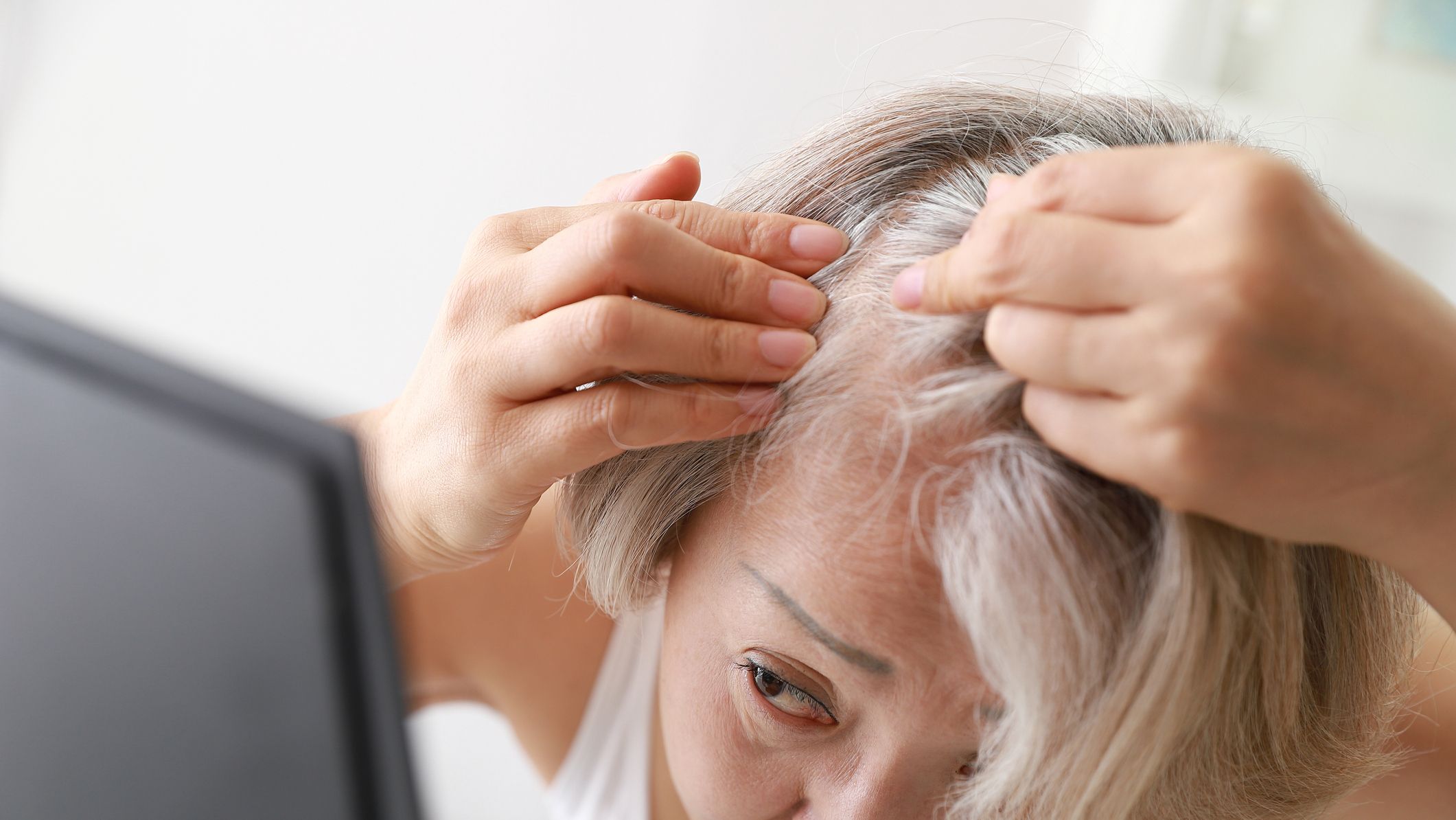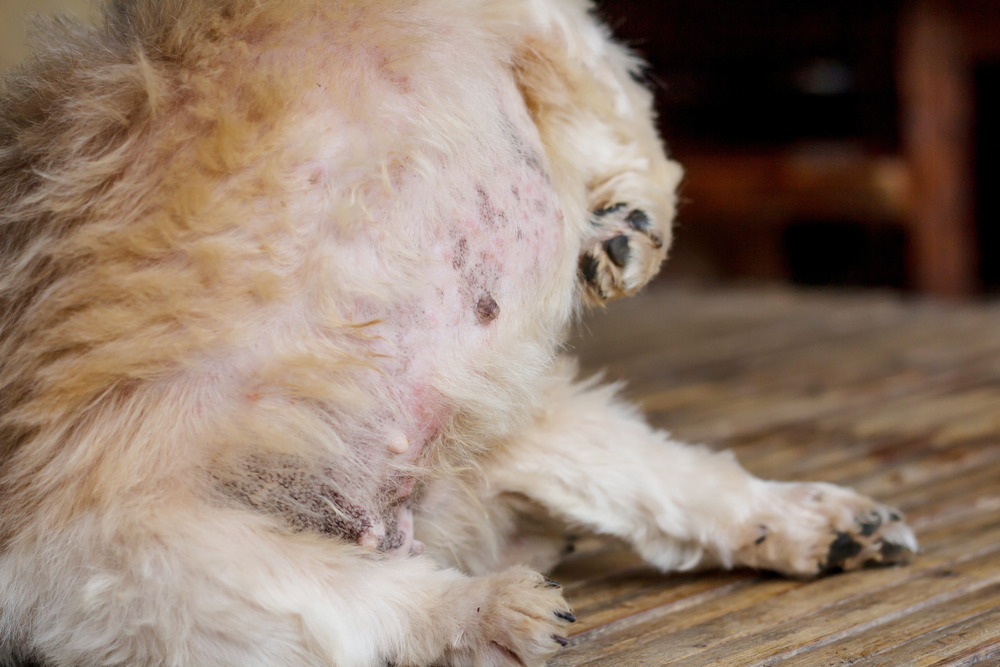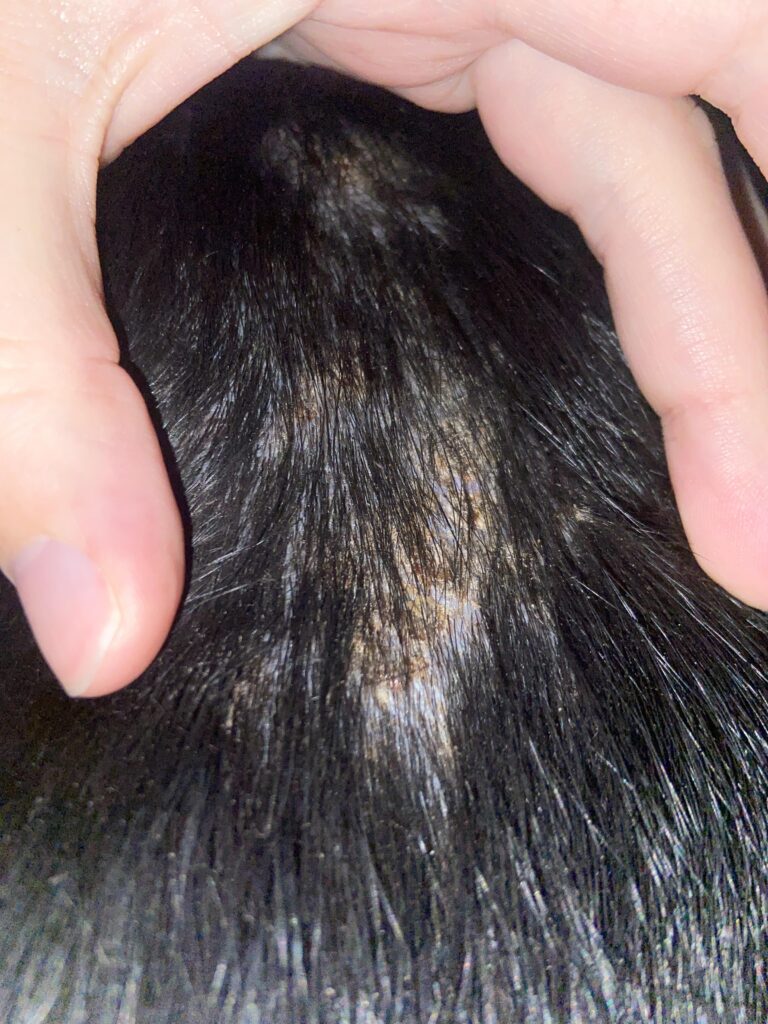Dog hair coming out in small clumps with scabs can be caused by allergic reactions to environmental factors such as mold, pollen, dust, and mites, leading to excessive itching, scratching, and hair loss. This can also be a result of stress, poor nutrition, pregnancy, lactation, or an underlying medical condition.
Scabs on dogs can develop from running through dense brush, scratches from a cat or a dogfight, self-trauma, excessive itching, or underlying allergies or a skin infection. Seborrhea in dogs can also cause hair loss and scabs, characterized by flakes, scales, greasiness, itchiness, and secondary infections.
If your dog is experiencing these symptoms, it is advisable to schedule an appointment with your vet to determine the underlying cause and provide appropriate treatment.

Credit: pawsafe.com
Causes Of Dog Hair Loss In Small Clumps & Scabs
When it comes to dog health, it’s important to pay attention to any changes in their coat, including hair loss in small clumps accompanied by scabs. While it can be concerning, there are several possible causes for this condition. Understanding these causes can help you determine the appropriate course of action and provide relief for your furry friend.
Environmental Allergies
One potential cause of dog hair loss in small clumps with scabs is environmental allergies. Dogs, just like humans, can be allergic to various allergens present in their surroundings. Common environmental allergens that may cause an allergic reaction in dogs include mold, pollen, dust, and mites. These allergens can trigger excessive itching and scratching, leading to the formation of bumps, rashes, scabs, and ultimately hair loss.
Underlying Medical Conditions
Another possible cause of hair loss in small clumps and scabs in dogs is underlying medical conditions. These conditions can range from hormonal imbalances to autoimmune diseases. In some cases, stress, poor nutrition, pregnancy, or lactation can also contribute to excessive shedding and hair loss. If you notice your dog shedding more than usual or developing bald patches, it’s essential to schedule an appointment with your veterinarian to rule out any underlying medical issues.
Skin Infections And Infestations
Skin infections and infestations can also result in hair loss in small clumps and the formation of scabs in dogs. Parasitic infestations, such as fleas and mites, can cause irritation, itching, and subsequent hair loss. Additionally, scratches from a cat or self-trauma due to excessive itching can lead to the development of scabs. Allergies or underlying skin infections can also contribute to widespread scab formation in dogs.
It’s imperative to thoroughly examine your dog’s skin and coat to determine the underlying cause of the hair loss in small clumps and scabs. Understanding the possible triggers for this condition will help you provide the necessary treatment and relief for your furry companion. Consulting with a veterinarian will ensure an accurate diagnosis and appropriate treatment plan to address the specific cause of your dog’s hair loss and scabs.
Symptoms And Effects Of Dog Hair Loss In Small Clumps & Scabs
When it comes to our furry friends, it can be alarming to see them experiencing hair loss in small clumps accompanied by scabs. This condition is not only uncomfortable for dogs but can also be a sign of an underlying health issue. In this section, we’ll explore the common symptoms and effects associated with dog hair loss in small clumps and scabs.
Excessive Itching And Scratching
Dogs experiencing hair loss in small clumps and scabs often have an overwhelming urge to itch and scratch their affected areas. This excessive itching and scratching can be a sign of an allergic reaction to environmental factors like mold, pollen, dust, or mites. It is essential to address this symptom promptly, as continuous scratching can lead to further damage to the skin, causing bumps, rashes, and scabbing.
Bumps, Rashes, And Scabbing
One of the visible effects of dog hair loss in small clumps and scabs is the development of bumps, rashes, and scabbing on the skin. These bumps may appear red, inflamed, or swollen, indicating an allergic reaction or irritation. The scabs can occur due to self-trauma or excessive itching, while the rashes and bumps can be a result of the dog’s skin coming into contact with allergens or irritants. Regularly inspecting and identifying these symptoms is crucial for proper diagnosis and treatment.
Patchy Hair Loss And Greasy Skin
Table:
| Possible Causes of Patchy Hair Loss and Greasy Skin |
|---|
| Parasitic infestations (such as fleas and mites) |
| Allergies (food or environmental) |
| Skin infections |
| Underlying medical conditions |
Along with the presence of small clumps and scabs, dogs may experience patchy hair loss and greasy skin. This can be attributed to various factors such as parasitic infestations (like fleas and mites), allergies (food or environmental), skin infections, or underlying medical conditions. The greasy skin may be accompanied by an unpleasant odor or visible discharge, indicating the need for veterinary attention.
Addressing these symptoms and effects promptly is vital for the well-being of your beloved furry companion. Consulting with a veterinarian can help determine the cause of the hair loss, provide appropriate treatment, and alleviate any discomfort your dog may be experiencing.
Solutions And Treatment For Dog Hair Loss In Small Clumps & Scabs
Does your dog have hair coming out in small clumps with scabs? This could be caused by allergies, parasites, or other underlying medical conditions. Schedule an appointment with your vet to determine the best solutions and treatment for your furry friend.
Addressing Allergies And Environmental Factors
If your furry friend is experiencing hair loss in small clumps with scabs, it could be due to allergies or environmental factors. Dogs, just like humans, can have allergic reactions to various substances such as mold, pollen, dust, and mites. These allergens can cause excessive itching and scratching, resulting in bumps, rashes, scabs, and hair loss. To address this issue, it is important to identify the specific allergens and take steps to minimize their impact on your dog.Consulting A Veterinarian For Diagnosis And Treatment
When dealing with dog hair loss in small clumps and scabs, it is crucial to consult a veterinarian for proper diagnosis and treatment. A veterinarian will be able to conduct a thorough examination of your dog’s skin, identify any underlying causes, and recommend the most appropriate treatment plan. They may perform tests to determine if there are any infections, infestations, or other skin conditions contributing to the hair loss. Seeking professional help is essential to ensure your dog receives the necessary care and treatment to promote healthy hair growth.Preventing And Treating Skin Infections And Infestations
Skin infections and infestations can also contribute to dog hair loss in small clumps and scabs. Fleas, ticks, mites, and other parasites can cause intense itching, leading to scratching and hair loss. Additionally, bacterial or fungal infections can further damage the skin, resulting in scabs and additional hair loss. To prevent and treat these issues, it is important to maintain a regular grooming routine for your dog, including regular baths and inspections for parasites. Your veterinarian may also prescribe medicated shampoos or topical treatments to address any existing infections or infestations. In conclusion, addressing allergies and environmental factors, consulting a veterinarian for diagnosis and treatment, and preventing and treating skin infections and infestations are vital solutions for dog hair loss in small clumps and scabs. By taking these steps, you can help your furry companion regain a healthy coat and prevent further hair loss. Remember, seeking professional advice is crucial for proper diagnosis and treatment.
Credit: www.prevention.com

Credit: betterpet.com
Frequently Asked Questions Of Dog Hair Coming Out In Small Clumps With Scabs
Why Is My Dog Losing Hair In Patches And Scabs?
Your dog may be losing hair in patches and developing scabs due to allergic reactions caused by environmental factors like mold, pollen, dust, and mites. Excessive itching and scratching can result in bumps, rashes, scabbing, and hair loss. It’s recommended to schedule a vet appointment if your dog is shedding more than normal or developing bald patches.
Why Is My Dogs Fur Coming Out In Clumps?
Excessive shedding, stress, poor nutrition, pregnancy, lactation, or underlying medical conditions can cause a dog’s fur to come out in clumps. If you notice excessive shedding or bald patches, consult a veterinarian for further evaluation and treatment.
Why Does My Dog Have Little Scabs Under Her Fur?
Your dog may have little scabs under her fur due to various reasons such as allergies, environmental factors, scratches from other animals, or self-trauma from excessive itching. These scabs can be caused by branches, thorns, or dense brush scraping their skin.
If the scabs are widespread, it could be a sign of underlying allergies or a skin infection. If you are concerned, it is best to seek advice from a veterinarian.
What Does Seborrhea Look Like On A Dog?
Seborrhea on a dog is characterized by the presence of flakes, scales, and crusty plaques on the skin. This chronic inflammatory disease may also cause greasiness, itchiness, and secondary infections.
Conclusion
If you’ve noticed your dog’s hair coming out in small clumps with scabs, it may be a cause for concern. Excessive shedding and scabbing can be indicative of underlying issues such as allergies, poor nutrition, or skin infections. To determine the exact cause and provide proper treatment, it’s recommended to consult with your veterinarian.
They will be able to assess your dog’s condition and provide the necessary care to improve their skin and coat health. Remember, a healthy coat is a reflection of your dog’s overall well-being.



